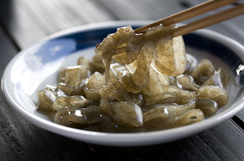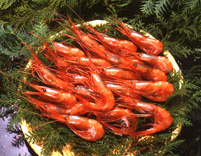Arts and Crafts
 On Sado Island a lot of people have traditionally been engaged in various arts and crafts. Bamboo work, straw work and textile art seem to have been commonly practiced as jobs that can be done indoors during the winter when the island is covered with snow.
On Sado Island a lot of people have traditionally been engaged in various arts and crafts. Bamboo work, straw work and textile art seem to have been commonly practiced as jobs that can be done indoors during the winter when the island is covered with snow.
On Sado abundant bamboo of excellent quality has been produced. Because of various uses and needs, it is said that a large number of bamboo trees used to be shipped out of Sado. They say that there are even some villages where bamboo enabled the people to make a fortune. A lot of people are engaged in bamboo work, which makes the most of such bamboo. Bamboo baskets, bowls and plates, whose beauty stems from their usefulness as commodities are drawing attention as excellent handicrafts, while bamboo vases and brooches are very popular as souvenirs.
As for straw work, such daily necessaries as sandals, pot stands and brooms are made of straw. In Shimebari, a village which used to belong to ex-Hamochi Town, the traditional horse-shaped straw handicraft called Shimebariuma has been made for more than 400 years. Shimebariuma have been made every year for the New Year and hung at the three entrances of the village as good-luch charms. You can get mini-sized ones as souvenirs.
"Sakiori" is a traditonal handicaft which is made from old clothes that were torn and woven again. In the Edo era sakiori was made mainly in the Tohoku region where clothing was regarded as precious because of the bitterly cold climate. The tasteful sakiori woven with great care is booming quietly these days. Don't you think we should make much of the "sakiori" culture which has been developed as part of culture of "using out" everything?
Pottery is also widely practiced, and in the Aikawa district, you can find Sado's original pottery called "Mumyoi-yaki." Mumyoi means products made of clay containing iron dioxide that has been dug out of Sado Gold Mine. Mumyoi-yaki is nationally famous as Sado's unique pottery. When it has been baked by fire, this type of pottery shrinks and hardens, which enables you to use it in its ungrazed state. What's more, the more you use it, the more lustrous it becomes, which will make you all the more attached to it.
The arts and crafts that have been preserved on Sado Island are all handmade, and have taken root in the lives of the local ordinary people. Please try to feel the "excellent work" that can be observed in the simplicity of those handicrafts.
Trivial information about Sado
*Because Sado's bamboo is considered to be of high quality, before glass fiber came to be widely used, Sado's bamboo is said to have been used as vaulting poles worldwide. Doesn't it fill your heart with deep emotion to think that in those days world records were made by making use of Sado's bamboo?
*Sado Island has produced three national living treasures: the late Mr. Shodo Sasaki (1882-1961), in the field of casting, including lost wax casting; and the late Mr. Koheiji Miura (1933-2006) and Mr. Sekisui Ito the 5th (1941-). From the Edo era up to the present day there have been many other people from Sado that we can boast of to the world.
Food Culture
 Sado is the island which is blessed with the bounties of the sea, the mountains, the rivers, and the countryside. It is the "treasure house" of delicacies in spring, summer, fall and winter―all the year round. Fresh fishes and shellfishes harvested from the waters around the island, wild plants from the hills and mountains, and farm products in season are among the best foods. The main farm product is the rice grown with subsoil water from the Osado and Kosado mountains. The main brand of rice produced on Sado is Koshihikari. Every year Sado produces enough rice to feed more 600,000 people. Next to Koshihikari produced in Uonuma, Sado's Koshihikari is said to be of the best quality. "Toki to Kurasu Sato Mai" (The rice of the countryside coexisting with crested ibises) is also popular as it is grown in the fields that cherish living things by people who hope the day will soon come when crested ibises can fully return to nature.
Sado is the island which is blessed with the bounties of the sea, the mountains, the rivers, and the countryside. It is the "treasure house" of delicacies in spring, summer, fall and winter―all the year round. Fresh fishes and shellfishes harvested from the waters around the island, wild plants from the hills and mountains, and farm products in season are among the best foods. The main farm product is the rice grown with subsoil water from the Osado and Kosado mountains. The main brand of rice produced on Sado is Koshihikari. Every year Sado produces enough rice to feed more 600,000 people. Next to Koshihikari produced in Uonuma, Sado's Koshihikari is said to be of the best quality. "Toki to Kurasu Sato Mai" (The rice of the countryside coexisting with crested ibises) is also popular as it is grown in the fields that cherish living things by people who hope the day will soon come when crested ibises can fully return to nature.
"Igoneri," one of the noted specialties of Sado is made from a kind of sea vegetable called "igogusa" which can be found only in the Sea of Japan. Igoneri is similar to Kyushu's "okyuto" in that it is made from igugusa. When eaten, igoneri feels like tokoroten, and a faint flavor of the sea spreads in the mouth. It is the "soul food" for the people of Sado.
 You can also enjoy teuchi-soba (handmade noodles) made from 100% buckwheat grown on Sado. Teuchi-soba, when eaten with soup flavored with broth from flyfish (called "ago" on Sado), has an enriched flavor of buckwheat, and goes well with the soup which has the smell of the sea. Flyfish is also ground and put into miso soup or a dish of vegetables boiled with soy sauce. These are also exceptionally delicious.
You can also enjoy teuchi-soba (handmade noodles) made from 100% buckwheat grown on Sado. Teuchi-soba, when eaten with soup flavored with broth from flyfish (called "ago" on Sado), has an enriched flavor of buckwheat, and goes well with the soup which has the smell of the sea. Flyfish is also ground and put into miso soup or a dish of vegetables boiled with soy sauce. These are also exceptionally delicious.
"Okesa-gaki persimmons,"one of Sado's specialties, are at their best and harvested in autumn. In Japan, as the old saying "When persimmons turn red, doctors turn pale" indicates, the persimmon is a very nuritious fruit. Sado's Okesa-gaki persimmons are distributed as one of the "brand" persimmons to the whole country with Hokkaido and the Kanto area as the main destinations. "Kaki" sherbet, which is made just by freezing persimmons, is a dessert unique to Sado.
The appeal of Sado as a "treasure house" of food can be most keenly felt in winter. It goes without saying that Sado's leading winter delicacy is "winter yellowtail." The winter yellowtail which has been harvested from the rough Sea of Japan is so oily as to repel soy sauce. In "Lake Kamoko," the largest lake in Niigata Prefecture, is noted for the farming of oysters. Such delicacies as doteyaki (grilled oysters) can be enjoyed at the lakeside. In additon, benizuwai-gani (snow crab) and nanban-ebi (Alaskan pink shrimp) are also at their best in winter, and you can taste them at the eating events held at various parts of Sado.
Good water and good rice enable people to make good Japanese sake. On Sado Island there are six breweries, five of which produce Japanese sake. There are many types of sake―such as sake the local people enjoy dirnking on the island, sake exported to restaurants in New York, and sake enjoyed in the first class seat of airliners. All of them are excellent and pleasant-tasting.
Enjoy bountiful food and get fuddled with Sado's original sake. You can experience such culture on Sado. Enjoy yourself to your heart's content―not just once, but many, many times.
Trivial information about Sado
*Anyone who is from Sado knows what igoneri is, which is proved by the fact that when local products are sold at a party for people from Sado, igoneri sells like hot cakes while some people may say, "It reminds me of home." If anyone asks, "Do you have igoneri?" at a product fair outside Sado Island, there is a high possibility that that person is from Sado.
*On Sado "okayu" (rice gruel) ordinarily does not mean "shirogayu" (plain rice gruel) but "chagayu" (rice gruel mixed with green tea). Like Nara, Sado is under the influence of the culture of Kyoto. On the day following a drink of sake, the islanders eat "chagayu" which is "friendly" to your stomach. This is one of the examples that show the richness of Sado's food culture.